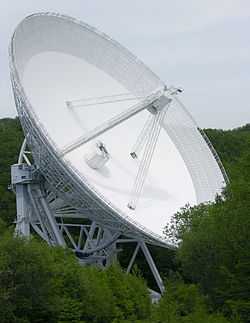Effelsberg 100-m Radio Telescope
|
Radio telescope at Effelsberg | |
| Organization | Max Planck Institute for Radio Astronomy in Bonn |
|---|---|
| Location | Effelsberg, North Rhine-Westphalia |
| Coordinates | 50°31′29″N 6°52′58″E / 50.52472°N 6.88278°ECoordinates: 50°31′29″N 6°52′58″E / 50.52472°N 6.88278°E |
| Altitude | 319 m |
| Wavelength | radio 408 MHz – 86 GHz |
| Built | 1971 |
| Telescope style | parabolic reflector |
| Diameter | 100 m |
| Collecting area | 7,850 m2 |
| Focal length | 30 m |
| Mounting | alt-azimuth fully steerable primary |
| Website | http://www.mpifr-bonn.mpg.de/8964/effelsberg |
The Effelsberg 100-m Radio Telescope is a radio telescope in the Ahrgebirge (part of the Eifel) in Bad Münstereifel, district of Euskirchen, North Rhine-Westphalia, Germany. For 29 years the Effelsberg Radio Telescope was the largest fully steerable radio telescope on Earth. In 2000 it was surpassed by the Robert C. Byrd Green Bank Telescope in Green Bank, West Virginia with an elliptical 100 by 110-metre aperture.[1]
Geography
The telescope is located about 1.3 km northeast of the village of Effelsberg, a southeastern part of the town of Bad Münstereifel. It is placed less than 300 m west of the 398 m high Hünerberg, which is already in the neighbouring Land of Rhineland-Palatinate.
In the vicinity of the telescope, the boundary of the Land of North Rhine-Westphalia is the Effelsberger Bach, which runs only a few metres east of the telescope. The Effelsberger Bach is 6.5 km long, flowing from the Effelsberger Wald into the Sahrbach, which in turn flows south and into the Ahr river.
A hiking path leads past the telescope; in 2004 part of this was turned into a planet trail with information panels about the Solar System with its planets. The trail ends at the 39 cm model of the Sun next to the visitor centre.
Radio telescope
The Effelsberg radio telescope is operated by the Max Planck Institute for Radio Astronomy in Bonn, the radio astronomy institute from the Max-Planck-Gesellschaft. It was constructed from 1968 to 1971 and inaugurated on 1 August 1972. A major technical difficulty in building a radio telescope of 100 m diameter was how to deal with the deformation as the – supposedly parabolic – mirror moves and tilts. The Finite element method was used to construct the mirror support in such a way that the deformed mirror will always take a parabolic shape. The focus will move during such deformation, and the receiver has to be moved accordingly. Tests after completion of the telescope showed that the intended accuracy of the mirror surface of 1 mm had not only been met, but exceeded significantly.
About 45% of the observing time is available to external astronomers. The Effelsberg 100-m telescope was involved in several surveys, including the one at 408 MHz (73 cm) by Haslam et al.[2][3]
| Reflector Diameter | 100 m |
| Aperture | 7,854 m2 |
| Number of Surface Elements (Panels) | 2,352 |
| Shape Accuracy of Surface | < 0.5 mm |
| Focal Length in Prime Focus | 30 m |
| Secondary Mirror Diameter (Gregory-Reflector) | 6.5 m |
| Aperture Stop | |
| – in Prime Focus | f/0.3 |
| – in Secondary Focus | f/3.85 |
| Angular Resolution (Beam Width) | |
| – at 21 cm wavelength (1.4 GHz) | 9.4' (arc minutes) |
| – at 3 cm wavelength (10 GHz) | 1.15' (arc minutes) |
| – at 3.5 mm wavelength (86 GHz) | 10" (arc seconds) |
| Azimuth Track Diameter | 64 m |
| Setting Accuracy of Track | ±0.25 mm |
| Azimuth Range | 480° |
| Maximum Rotation Speed | 30°/min. |
| Pointing Accuracy | |
| – Blind Pointing | 10" |
| – Repeatability | 2" |
| Power Output of the 16 Azimuth Drives | 10.2 kW each |
| Radius of Elevation Gear Track | 28 m |
| Elevation Range | from 7° to 94° |
| – during observations | from 8.1° to 89° |
| Maximum Tilt Speed | 16°/min. |
| Power Output of the 4 Elevation Drives | 17.5 kW each |
| Total Weight | 3,200 t |
| Construction Period | 1968–1971 |
| Height of Track above Sea Level | 319 m |
| Commencement of Operation | 1 August 1972 |
| Constructed by | Arbeitsgemeinschaft Krupp/MAN |
See also
| Wikimedia Commons has media related to Radiotelescope Effelsberg. |
| Wikimedia Commons has media related to Effelsberg. |
- Radio astronomy
- Radio telescope
- Stockert Radio Telescope
- Lovell Telescope at Jodrell Bank Observatory
External links
- Official website of the Max Planck Institute for Radio Astronomy
- Dr Norbert Junkes video interview on Astrotalkuk.org
- Effelsberg Official Webpage
- Bill Keel's "Telescopes I've seen"
References
- ↑ Newly Commissioned Green Bank Telescope Bags New Pulsars, NRAO, 2002-01-04
- ↑ Haslam, C. G. T.; Salter, C. J.; Stoffel, H.; Wilson, W. E., A 408 MHz all-sky continuum survey. II – The atlas of contour maps, Astronomy and Astrophysics Supplement Series, vol. 47, Jan. 1982, p. 1, 2, 4–51, 53–142.
- ↑ http://adsabs.harvard.edu/cgi-bin/bib_query?1981A%26A...100..209H
- ↑ http://www3.mpifr-bonn.mpg.de/div/effelsberg/antenna/antenna_spec.html
